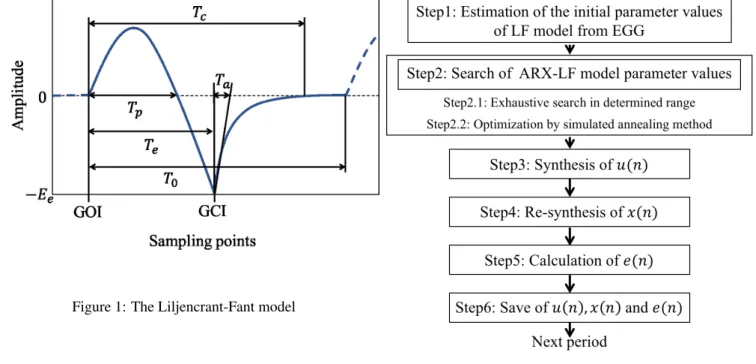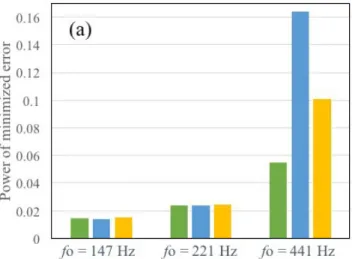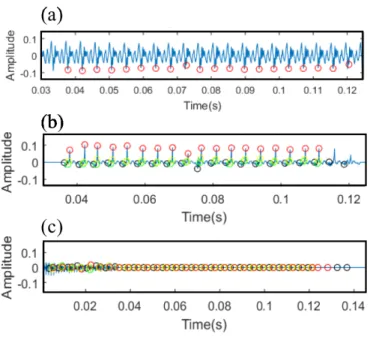JAIST Repository
https://dspace.jaist.ac.jp/Title
Estimation of glottal source waveform and vocal
tract shape for singing-voice analysis
Author(s)
Takahashi, Kyoko; Akagi, Masato
Citation
2018 RISP International Workshop on Nonlinear
Circuits, Communications and Signal Processing
(NCSP2018): 691-694
Issue Date
2018-03-07
Type
Conference Paper
Text version
publisher
URL
http://hdl.handle.net/10119/15088
Rights
Copyright (C) 2018 Research Institute of Signal
Processing, Japan. Kyoko Takahashi and Masato
Akagi, 2018 RISP International Workshop on
Nonlinear Circuits, Communications and Signal
Processing (NCSP2018), 2018, 691-694.
Estimation of glottal source waveform and vocal tract shape for singing-voice analysis
Kyoko Takahashi and Masato Akagi
Graduate School of Advanced Science and Technology, Japan Advanced Institute of Science and Technology 1–1 Asahidai, Nomi, Ishikawa 923–1292 Japan
E-mail:{ kyoko.takahashi, akagi } @jaist.ac.jp
Abstract
In this paper, an effective method to estimate the glottal source waveform and the vocal tract shape in singing voice was proposed based on ARX-LF model. Previous methods suffered from estimation of the glottal source waveform and the vocal tract shape in singing voices with high fundamen-tal frequencies because of effects from forwarded periods. In the proposed method, parameters of the ARX-LF model were estimated accurately with exhaustive search in deter-mined range and a simulated annealing method. Addition-ally, singing voice was synthesized using the estimated re-sults of the vocal tract filter and periodic glottal source wave-form with a length of settling time for considering the effects from forwarded periods. As a result of analysis using simu-lated singing voice data and actual sung voice data, the ac-curacy of estimation of the parameter values of the ARX-LF model from singing voices with wide range of fundamental frequency can be achieved by the proposed method.
1. Introduction
Speech and singing voice are defined as an output of a vo-cal tract filter with a glottal source based on source-filter the-ory [1]. Temporal fluctuations of glottal vibration and vo-cal tract shapes can be obtained by estimating glottal source waveform and vocal tract filter. Several analysis methods have been proposed based on the theory. Ding and Kasuya proposed a speech analysis-synthesis method based on auto-regressive with exogenous input (ARX) model, which was a model of vocal tract filter, and Rosenberg-Klatt (RK) model, which was a model of glottal source waveform [2]. Their method accurately estimated the vocal tract filter using the Kalman filer algorithm. Ohtsuka and Kasuya improved esti-mation to be able to analyze high-pitch speaking voice using the Least Square method [3]. They reported that the method can analyze voices spoken by females and children as well as male voices. Vincent et al. proposed another method for speech analysis and synthesis based on the ARX model and Liljencrants-Fant (LF) model [4]. They analyzed simulated speech data and female speaking voice. Their method accu-rately estimated speech data with low fundamental frequency.
Several methods based on the ARX-LF model have been reported for singing voice analysis and synthesis. Lu and Smith III focused on glottal aspiration noise in singing voice. They proposed the method for extraction and synthesis of the glottal aspiration noise in singing voices [5]. Motoda and Ak-agi investigated features of glottal source waveform in each vocal register by analyzing singing voices using the ARX-LF model [6]. As a result, differences of glottal source wave-forms were found among vocal registers.
However, the previous methods [5,6] suffered from ac-curate estimation of the glottal source waveform of singing voice. Inaccurate detection of the glottal closure instant (GCI) caused inaccurate estimation of the glottal source waveform. Li et al. detected GCI using Electroglottogram (EGG) signal and estimated parameter values of the ARX-LF model of emotional speech [7]. Nevertheless, their method cloud not accurately estimate the speech with high fundamen-tal frequency (fo).
Singers can sing songs fluently changingfo in their voice freely not only within one vocal register but also among sev-eral registers. Therefore, estimation of the glottal source waveform and the vocal tract shape accurately in wide fo range is required to obtain characteristics of singing voices.
The objective of this paper is to propose a method of accu-rate estimation of the glottal source waveform and the vocal tract shape for singing voices whosefos are in wide range. In this paper, effects of forwarded periods are suggested as a cause of inaccurate estimation of singing voice with highfo. In singing voices with highfo, the settling time of the vocal tract filter exceeds a length of each periods and the responses of the vocal tract filter of the forwarded periods leak into the target period. Thus, singing voice is re-synthesized using the estimated ARX-LF parameter values to estimate the leaked components.
2. Estimation method for glottal source waveform and vocal tract
2.1 ARX-LF model
sig-Figure 1: The Liljencrant-Fant model
nal with 6 parameters [8,9]: five parameters concerning time
Tp, Te, Ta, Tc and T0, and one parameter concerning
ampli-tude Eeas shown in Fig.1. Tpis the phase where maximum
value of glottal flow occurs, Teis the open phase of the
glot-tis, Ta is the return phase, Tc is the end of return phase and T0is the length of period. In Fig.1, GOI is the glottal open-ing instant. The LF model in time domain is defined as the following equation: u(t) = E1eatsin(ωt) 0≤ t ≤ Te −E2[e−b(t−Te)− e−b(T0−Te)] T e≤ t ≤ Tc 0 Tc≤ t ≤ T0 (1)
where the parameters E1, E2, a, b and ω are related
Tp, Te, Ta, Tc, T0and Ee. The ARX model simulates a vocal
tract filter. The speech signal s(n) is simulated as a following equation by means of an ARX model [2]:
s(n) + p
∑
k=1
ak(n)s(n− k) = u(n) + e(n) (2)
where ak(n) is time-varying coefficients of the pth-order AR
filter characterizing the vocal tract, u(n) is the glottal flow derivative (periodic waveform) and e(n) is the residual signal of the ARX model and the aspiration noise (aperiodic wave-form). The output of the LF model is the input signal u(n) to the vocal tract filter. The re-synthesized signal x(n) is repre-sented as the following equation:
x(n) = p
∑
k=1
ak(n)s(n− k) + u(n) (3)
Figure 2: Analysis process of the proposed method
2.2 Procedures for estimation
Figure2shows overview of the proposed procedure for es-timation of the glottal source waveform and the vocal tract fil-ter. In steps 1 and 2, parameter values of the ARX-LF model are estimated. Singing voice is re-synthesized to consider in-fluence from forwarded periods in steps 2 and 4.
Step 1 is the phase for estimating of the initial parame-ter values of the LF model using EGG signal to deparame-termine the range of exhaustive search. According to the previous method [7], the initial parameter values of the LF model are obtained from a fixed GCI from a differential EGG. The ranges of exhaustive search are determined using these initial parameters of the LF model.
Step 2 is the phase for searching the optimum values of each parameter of the ARX-LF model. In step 2.1, value of each parameter of the ARX-LF model is explored using ex-haustive search in each determined range. In step 2.2, the parameter values of the ARX-LF model are optimized using a simulated annealing method in the small range including the obtained parameters in step 2.1. The conditions of the ex-haustive search and the simulated annealing are expressed as the following equations:
minimize f =∑{s(n) − x(n)}2 limitation 0 < Tp< Te< T0
0.8 < Tc/T0< 1 0.01 < Ta/T0< 1
u(n) and x(n) are obtained by the same process as steps 3
and 4.
Steps 3, 4 and 5 are the phases for synthesizing u(n), re-synthesizing x(n) and calculating e(n). In steps 3, 4 and 5, the vocal tract shape is assumed to be time-invariant during several periods. First of step 3, u(n) is synthesized using the estimated the parameters of the LF model. Second, ul(n)
with a length of over settling time is made using u(n). In step 4, xl(n) is re-synthesized by inputting ul(n) into the
es-timated vocal tract filter. x(n) is the backward periods of
xl(n). In step 5, e(n) is calculated using s(n), x(n) and the
estimated vocal tract filter. 3. Evaluation
3.1 Experiment using simulated singing voice
Simulated singing voice were prepared using Kawahara’s method [10]. The LF parameters were set as follows; Te/T0 is 0.3 to 0.5 with steps of 0.1 and 1/T0 (= fo) is fixed as 147, 221, 441 Hz. Each glottal source waveform is assumed as ideal condition without aspiration noise of glottis. This means that the power of the minimized error is 0 theoretically. The power of the minimized error ε(n) is expressed as the following equation:
ε(n) = 1 M
∑
e(n)2 (5)
where M is the number of samples in e(n). The typical vowel /a/ is considered for the filter. The sampling frequency of the simulated singing voices was 44.1 kHz.
Figure 3(a) shows the power of the minimized error by the previous method [6] in each simulated condition. Figure
3(b)shows the power of the minimized error by the proposed method. As Fig.3(b), the power of the minimized error was almost 0 in each condition, especially the results of data with
fo as 147 Hz and 221 Hz. Comparing Figs.3(a) and(b), the power of the minimized error by the proposed method was smaller than that by the previous method: decreasing in 91.8% for 147 Hz, decreasing in 84.2% for 221 Hz and de-creasing in 71.9% for 441 Hz. As a result, accurate estimation of singing voices in wide rangefo is achieved using the pro-posed method.
3.2 Experiment using the real singing voice
Real singing voices were baritone singing voice sung with vowel /a/. One singing voice waveform is shown in Fig.4(a). This data was offered by Prof. Tsuzaki, Kyoto City University of Arts, and included singing voice waves and EGG signals. The fo of this data was 233 Hz estimated by STRAIGHT (STRAIGHTV40 006b) [11]. The sampling frequency of the singing voice data was 44.1 kHz.
Figure 3: Power of minimized error of simulation data, (a) by the previous method and (b) by the proposed method
Figure4(b) and (c) shows the estimated e(n) by the previ-ous method and the proposed method. e(n) by the previprevi-ous method was observed a periodic component shown in Fig.
4(b). e(n) by the proposed method was observed only an aperiodic waveform in Fig.4(c). Theoretically, u(n) consists of periodic components and e(n) consists of aperiodic com-ponents. Therefore, Fig.4(c) is indicated that the proposed method could estimate glottal source waveform accurately.
4. Conclusions
This paper proposed an effective method to estimate the glottal source waveform and the vocal tract filter of singing voices. Two evaluational experiments were carried out using
Figure 4: The results of a baritone singing voice /a/, (a) real singing voice, (b) estimated result of e(n) by the previous method, (c) estimated result of e(n) by the proposed method
the simulated singing voice whose fo are low, middle and high, and the real singing voice. Reduction of the power of the minimized error was found in the results of the simulated singing voice. As a result, it is indicated that the proposed method could accurately estimate the glottal source waveform and the vocal tract filter of singing voice with wide range of
fo. The results of the real singing voice indicated that the proposed method could be applied to estimate the parameter values in real singing voices.
Acknowledgments
This study was supported by a rant-in-Aid for Scientific Re-search (A) (No. 25240026). The authors would like thank Prof. Minoru Tsuzaki and Jun Takahashi, in Kyoto City Uni-versity of Arts, for offering the sung-voice data.
References
[1] G. Fant: The source filter concept in voice production, STL-QPSR, Vol. 22, No. 1, pp. 21–37, 1981.
[2] W. Ding and H. Kasuya: Simultaneous estimation of vocal tract and voice source parameters based on an ARX model, IEICE TRANS. INF. & SYST. Vol. E78– D, No. 6, 1995.
[3] T. Ohtsuka and H. Kasuya: An Improved speech analysis-synthesis algorithm based on the auto
regres-sive with exogenous input speech production model, 6th International Conference on Spoken Language Process-ing (ICSLP 2000), Vol. 2, pp. 787-790, 2000.
[4] D. Vincent, O. Rosec and T. Chonavel: Estimation of LF glottal source parameters based on ARX model, In-terspeech, pp. 333–336, 2005.
[5] H. Lu and J. O. Smith III: Glottal source modeling for singing voice synthesis, in Proceedings of the 2000 International Computer Music Conference, Vol. 2000, 2000.
[6] H. Motoda and M. Akagi: A singing voices synthe-sis system to characterize vocal registers using ARX-LF model, 2013 International Workshop on Nonlin-ear Circuits, Communications and Signal Processing (NCSP’13), Hawaii, USA, pp. 93–96, 2013.
[7] Y. Li, K. Sakakibara, D. Morikawa and M. Akagi: Commonalities of glottal sources and vocal tract shapes among speakers in emotional speech, The 11th Inter-national Seminar on Speech Production (ISSP 2017), Tianjin, China, 2017.
[8] G. Fant, J. Liljencrants and Q. Lin: A four-parameter model of glottal flow, STL-QPSR, Vol. 26, No. 4, pp. 1– 13, 1985.
[9] Q. Fu and P. Murphy: Robust Glottal Source Estimation Based on Joint Source-Filter Model Optimization, IEEE Transactions on Audio, Speech, and Language Process-ing, Vol. 14, No. 2, pp. 492–501, 2006.
[10] H. Kawahara, K. Sakakibara, H. Banno, M. Morise, T. Toda and T. Irino: Aliasing-free implementation of discrete-time glottal source models and their applica-tions to speech synthesis and F0 extractor evaluation, Signal and Information Processing Association Annual Summit and Conference (APSIPA), 2015 Asia-Pacific, Hong Kong, pp. 520–529, 2015.
[11] H. Kawahara: STRAIGHT, Exploration of the other as-pect of VOCODER: Perceptually isomorphic decompo-sition of speech sounds, Acoustic Science and Technol-ogy, Vol. 27, No. 6, pp. 349-353, 2006.


